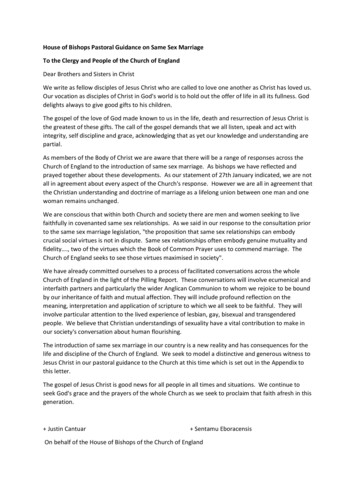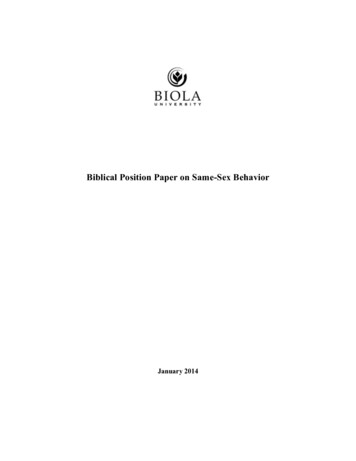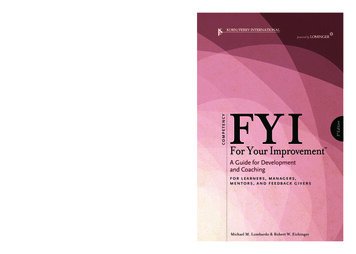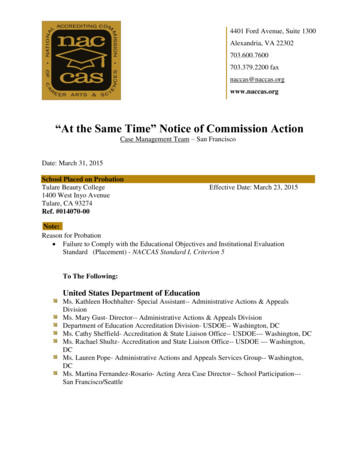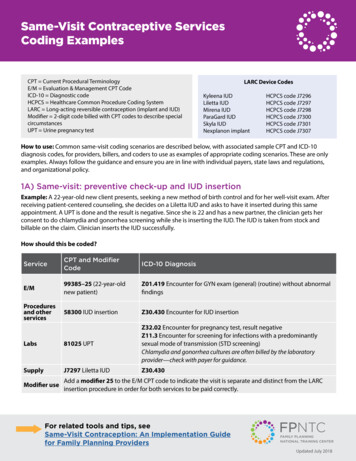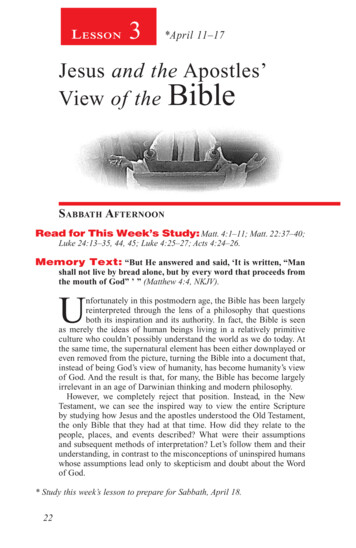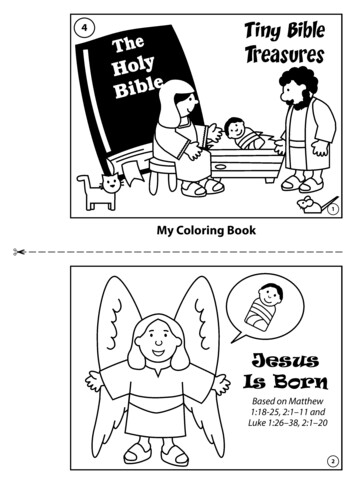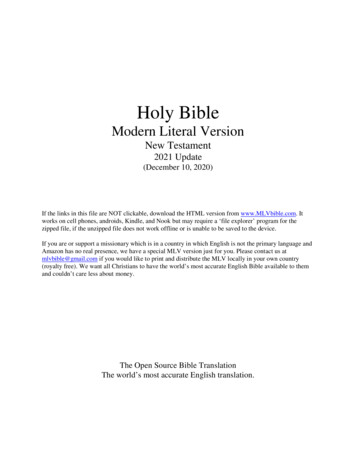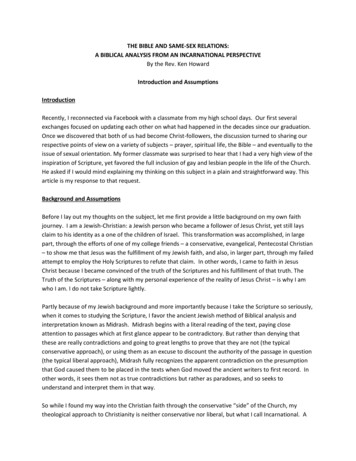
Transcription
THE BIBLE AND SAME-SEX RELATIONS:A BIBLICAL ANALYSIS FROM AN INCARNATIONAL PERSPECTIVEBy the Rev. Ken HowardIntroduction and AssumptionsIntroductionRecently, I reconnected via Facebook with a classmate from my high school days. Our first severalexchanges focused on updating each other on what had happened in the decades since our graduation.Once we discovered that both of us had become Christ-followers, the discussion turned to sharing ourrespective points of view on a variety of subjects – prayer, spiritual life, the Bible – and eventually to theissue of sexual orientation. My former classmate was surprised to hear that I had a very high view of theinspiration of Scripture, yet favored the full inclusion of gay and lesbian people in the life of the Church.He asked if I would mind explaining my thinking on this subject in a plain and straightforward way. Thisarticle is my response to that request.Background and AssumptionsBefore I lay out my thoughts on the subject, let me first provide a little background on my own faithjourney. I am a Jewish-Christian: a Jewish person who became a follower of Jesus Christ, yet still laysclaim to his identity as a one of the children of Israel. This transformation was accomplished, in largepart, through the efforts of one of my college friends – a conservative, evangelical, Pentecostal Christian– to show me that Jesus was the fulfillment of my Jewish faith, and also, in larger part, through my failedattempt to employ the Holy Scriptures to refute that claim. In other words, I came to faith in JesusChrist because I became convinced of the truth of the Scriptures and his fulfillment of that truth. TheTruth of the Scriptures – along with my personal experience of the reality of Jesus Christ – is why I amwho I am. I do not take Scripture lightly.Partly because of my Jewish background and more importantly because I take the Scripture so seriously,when it comes to studying the Scripture, I favor the ancient Jewish method of Biblical analysis andinterpretation known as Midrash. Midrash begins with a literal reading of the text, paying closeattention to passages which at first glance appear to be contradictory. But rather than denying thatthese are really contradictions and going to great lengths to prove that they are not (the typicalconservative approach), or using them as an excuse to discount the authority of the passage in question(the typical liberal approach), Midrash fully recognizes the apparent contradiction on the presumptionthat God caused them to be placed in the texts when God moved the ancient writers to first record. Inother words, it sees them not as true contradictions but rather as paradoxes, and so seeks tounderstand and interpret them in that way.So while I found my way into the Christian faith through the conservative “side” of the Church, mytheological approach to Christianity is neither conservative nor liberal, but what I call Incarnational. A
The Bible & Same-Sex Relations 2simple way of explaining this approach is that it always asks the question, “If Christ, then what?” It iswhat mathematicians would call a “centered set” approach to Christian Community: a hard center (thereality of the Risen Christ), with little or no definition of boundaries. What makes us Christian is notdifferentiation from other religions based on doctrine or practice, but the love of Christ and ourorientation toward that love and its Source.It is an unavoidably Christ-centered approach to Scripture, which takes most literally and seriously of allthe words of Christ, using the Truth that is Jesus Christ, revealed in the Gospels, as the lens throughwhich to view the entirety of the rest of the Bible. It is an unavoidably inclusive way of looking atChristian community and Christian unity, because the Jesus’ way of being was unmistakably inclusive.He sought and associated himself with all sorts and conditions of unclean and outcast people –taxcollectors and sinners (Mt 9:10; Mk 2:15; Lk 5:29, 15:1), prostitutes (Mt. 21:31), the unclean (Lk 9:20),and Gentiles both male (Mt 8:5; Lk 7:2, 17:16) and female (Mt 15:22, Mk 7:26, Jn 4:7 – apparentlywithout any precondition or prejudgment and occasionally with statements of praise for their faith inhim (Mt 21:31, 26:10). Perhaps Jesus’ most straightforward statement of the inclusiveness of hispurpose may be found in his assertion that “If I am lifted up, I will draw all people to myself” (Jn 12:32,cf. Lu 3:6). Similarly, radical inclusion based on Christ’s love was central to the teaching and practice ofthe Paul (Gal 3:28; Rom 5:18, 11:32; 1 Cor 15:22; Col 1:20; Php 2:11) and other Apostles (Acts 8:26-40,10:1-48, 15:1-41), and was integral to the Way of Paul’s early Christian communities.What is more, in his parables, Jesus makes it abundantly clear that human beings are singularly poorjudges not only of the state of other people’s relationships with God but also of our own (Ma 25:31-46).And because of this shortcoming we are warned against trying to sort out who is for God and who isagainst, leaving that discernment to God (Ma 13:18-33), and contenting ourselves with fulfilling theGod’s Law by obeying God’s two most challenging commandments: to love God with all that we are andto love our neighbor as ourselves (Lu 10:25-28).Therefore, when the question presented for Biblical analysis is the inclusion or exclusion of any group ofhuman beings, the default position must be that the group must be included unless a clear, convincing,and indisputable Biblical case, rooted in and consistent with our understanding of Jesus Christ, can bedemonstrated. In other words, the burden of proof lies on those who would exclude rather than thosewho would include. So we begin by examining the Biblical case for exclusion of gay and lesbian peoplefrom full participation in the life of the Church.Examining the Case for Exclusion of Gay and Lesbian PeopleThe Biblical Case for ExclusionMost Biblical authorities would agree that the Biblical case for the exclusion of gay and lesbian peoplerests on the following texts: Genesis 19 (The story of Sodom and Gomorrah) Judges 19:14-29 (The story of Gibeah)February 14, 2013 2013 by Ken Howard – use permitted with attribution
The Bible & Same-Sex Relations 3 Leviticus 18:22 and 20:13 (“ it is an abomination.”)Romans 1 (“ God has given them up to vile affections, [including] ”)1 Corinthians 6 (“ the unrighteous shall not inherit the kingdom of God, [including] ”)1 Timothy 1 (“the lawless and the disobedient [including]”)The question before us is whether these passages constitute an irrefutable case against inclusion.Frequency and EmphasisA necessary (though not sufficient) way to begin to answer these questions is to ask how frequently andconsistently theme appears. Is it referenced in all (or most) of the books of the Bible? If not, inwhich/which kinds of books? By whom and to whom?In this case of same-sex sexual activity, the answers are fairly enlightening. Out of the 66 books, 1,100 chapters, and roughly 31,000 verses of the Bible, six or seven mentions in six of those books is arelatively light footprint, especially when you consider that none of these passages are from theGospels, none are the spoken by Jesus, and half of the Hebrew Scripture passages are from thecommandments of Levitical “holiness code,” which the vast majority of Christian’s do not practice today.It is a pretty thin slice of the Scriptures on which to rest an argument excluding an entire category ofhumanity from full participation in the life of the Church. This becomes especially obvious when youconsider that vast numberHowever, statistics, while instructive, do not theological arguments make. We need to more closelyexamine the Biblical texts on which the proposed exclusion of gay and lesbian people rests.What Did Jesus Say?To view this question through the lens of Jesus Christ, we first have to ask whether we have anyevidence of Jesus speaking unambiguously on the issue. And the answer is no.Jesus is silent on the issue of gay and lesbian sexual activity. Jesus says nothing about same-sexattraction or behavior, either directly in favor of or opposed to it.Yet Jesus does address sexual immorality. While Jesus is silent on same-sex sexuality, he does speak toissues of sexual immorality: “Evil thoughts, murders, adulteries, fornications, thefts, false witness, blasphemies. These arethings that defile” (Matt 15:18-20); “Tax collectors and the prostitutes are going into the kingdom of God ahead of you” Matt.21:28-32); “Go and sin no more” [to the woman caught in adultery] (John 8:3-11).February 14, 2013 2013 by Ken Howard – use permitted with attribution
The Bible & Same-Sex Relations 4Jesus also addresses heterosexual marriage. Speaking against the ease with which men were able todivorce their wives, leaving them destitute and without hope of supporting themselves, save begging orprostitution, Jesus said “So they are no longer two but one flesh. Therefore, what God has joinedtogether, let no one separate” (Mt. 19:6ff, cf. Mk 10:8). Given the context (answering the Pharisees’question about divorce), it is more accurate to say that Jesus is primarily speaking against divorce andsecondarily speaking for marriage.How do we interpret Jesus’ silence on same-sex sexual activity? While Jesus’ comments onheterosexual immorality and marriage are secondary considerations to the issue of same-sex sexualactivity, the fact that he does deal with issues of heterosexual immorality are significant to the extentthat it demonstrates that he did not avoid teaching about sexual or moral issues, or responding toquestions about them. Therefore, regarding Jesus’ silence on same-sex sexuality, the followingconclusions, in what I would consider to be decreasing likelihood, are open to us: Jesus did not consider it a sin, Jesus did not consider it a significant sin (more like a minor infraction), Jesus did consider it a significant sin, but neglected to mention it, or Jesus did consider it a significant sin, and said so, but the Gospel writers omitted it.So while we cannot completely rule out the possibility that Jesus had a negative opinion of same-sexsexuality, we can unequivocally state that he had numerous opportunities to do so, without anyevidence that he ever did so.What did Moses say?The heading above probably should have been “What do the Hebrew Scriptures say?” but I’m a suckerfor parallelism. We now turn to the four passages of the Hebrew Scriptures offered as part of the caseagainst same-sex sexuality: Leviticus 18:22 and 20:13 (“ it is an abomination.”) Genesis 19 (The story of Sodom and Gomorrah) Judges 19:14-29 (The story of Gibeah)Leviticus 18:22 (and 20:13)“You shall not lie with a male as with a woman; it is an abomination.” (Leviticus 18:22 – NRSV)“If a man lies with a male as with a woman, both of them have committed an abomination; theyshall be put to death; their blood is upon them.” (Leviticus 20:13 – NRSV)Context Changes Connotations. These two verses from the book of Leviticus are among the half-dozenpassages offered as proof that same-sex sexual activity is abhorrent to God. Reading these verses forFebruary 14, 2013 2013 by Ken Howard – use permitted with attribution
The Bible & Same-Sex Relations 5the first time, without the context of the surrounding verses, one could certainly be forgiven for readingthem as straightforward condemnations of same-sex sexual activity.However, when one considers the historical-cultural and Scriptural contexts of the passages theirconnotations begin to seem quite different. The historical-cultural context makes it clear that that amajor thrust of the teaching found in Leviticus is to dissuade the people of Israel from adopting thePagan practices of the peoples among whom they lived. The Scriptural context also makes this clear.Examining the two chapters in which these verses are found, chapter 18 contains the most detailed andexhaustive list of prohibitions of the two, while chapter 20 seems to be a summary of offenses andpunishments. Thus, chapter 18 provides the best context.Examining Leviticus 18:22 in the context of the entirety of chapter 18, there are several indications thatwhat is condemned in the verse is not same-sex sexual activity, per se:Non-Apodictic Form. Divine commandments found in the Hebrew Scriptures take either of two forms:apodictic or casuistic. Apodictic commands, such as the Ten Commandments, are limited in number, butabsolute and general in scope, applying to all people in all situations for all time. Casuistic commands,on the other hand, are contextual and case specific, applying to some groups of people, in somesituations, or for a limited time, but appear in the Scripture in greater numbers. The Levitical “HolinessCode” and rules for sacrifice are but two of many examples. When apodictic commands apply to bothmen and women, they are written in a form which is either gender-neutral (e.g., “You shall not kill”) orcontains parallel prohibitions for males and females (e.g., nocturnal emissions make males ceremoniallyunclean, while menstrual flows make females ceremonially unclean).If Leviticus 18:12 were intended as an apodictic command against all same-sex activity, by both sexes,for all time, it would have been constructed differently: either as a single, general command against allsame-sex sexual activity (omitting the male-with-male reference), or including containing parallelprohibitions for both sexes (adding a prohibition against female-with-female sexual activity). Readingthis text literally and assuming it is a prohibition against, same-sex sexual activity, we can only interpretthis as prohibiting male-male sex but permitting female-female sex. As this seems an unlikelyinterpretation, we must assume that it is not a prohibition against same-sex activity, per se, but rather aprohibition against some other kind of activity, which happens to include a sexual component.So we a
THE BIBLE AND SAME-SEX RELATIONS: A BIBLICAL ANALYSIS FROM AN INCARNATIONAL PERSPECTIVE By the Rev. Ken Howard Introduction and Assumptions Introduction Recently, I reconnected via Facebook with a classmate from my high school days. Our first several exchanges focused on updating each other on what had happened in the decades since our graduation. Once we

